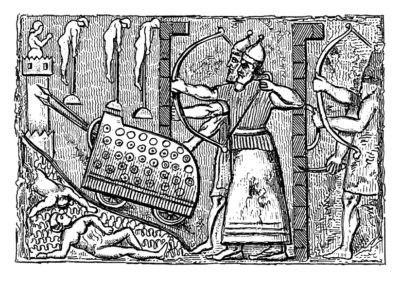The goal of the Assyrian state was the creation of a unified world order; its methods were warfare, brutality, and terror.
—Greg Uttinger, Prologue, A Christian Guide to Ancient History (2004)
What Isaiah was condemning was Assyria’s self-confidence . . . reliance should be upon God alone.
—H. W. F. Saggs, The Might That Was Assyria (1984)
Assyria Lost and Found
The Assyrian empire stretched at its peak for a distance of 2,000 miles across the deserts, grasslands, and mountains of Asia Minor, from Egypt to India, from Russia to Arabia. Or as the Assyrians themselves put it, “From the borders of the distant mountains . . . as far as the upper sea of the setting sun.” The heart of the empire lay along the banks of the Tigris River in Mesopotamia. Its first capital was Asshur. Its second, Nineveh, was originally built by Nimrod in the wake of mankind’s dispersion from Babel.
The Assyrian empire endured, low tide and high tide, for a thousand years. And then, attacked by enemies from all sides, it collapsed. Its greatest cities faded, deteriorated, and “dissolved, transformed by nature into grassy mounds fit for sheepfolds.” Historian Arnold Brackman describes it this way, “Nothing remained of either Nineveh or Assyria except vague memories, legends, myths, and traditions handed down in profane and sacred literature. Not a scrap of tangible evidence survived to prove that Nineveh ever existed.” And so, at the beginning of the 1800s, scholars and skeptics freely questioned the very existence of Nineveh, the historicity of the Assyrian empire, and the infallibility of Scripture.
But in 1838 a young Englishman set out to walk across Europe and the Middle East to look for work in Ceylon, then a distant but profitable corner of the British Empire. Austen Henry Layard never made it to Ceylon or even India. He got sidetracked by adventure and antiquities. In particular, he developed a fascination for a huge mound of earth that lay across the Tigris from the decaying city of Mosul. Others poked about the mound before he could manage serious excavations, but it was Layard who first dug deep enough to turn up the ancient marble cherubim or sphinxes that once guarded the palace of Assyrian kings. Layard discovered the remains of Nineveh. And Assyria was back in the history books.
The New World Order
Nimrod, who first built Nineveh, had been the first empire builder after the Flood. He began his career at Babel, and after divine judgment fell on that project, he continued to promote the same vision through military conquest and city-building: one-world order, paradise restored, the deification of man, and all apart from God. What Nimrod began, Mesopotamian culture perpetuated.
The Mesopotamian worldview understood the whole cosmos as a single State ruled by the assembly of the gods. Earthly empires were obvious, though not necessary, manifestations of that comic State. In other words, here was a polytheism that applauded imperial conquest. The conquering king was an agent of divine unity, and as long as he succeeded, he was the divine will incarnate for that hour.
The Assyrian kings came to speak of themselves in terms appropriate to this vision; here’s an example:
I am Shalmaneser, the legitimate king, the kind of the world, the king without rival, the Great Dragon, the only power within the four rims of the earth, overlord of all princes who has smashed all his enemies as if they be earthenware, the strong man, unsparing who shows no mercy in battle.
As the personal representative of deity, the kings of Assyria were not accustomed to showing humility.
The Might That Was Assyria
The Assyrians were pragmatic and harsh in their empire-building. First, the Assyrian armies used terror as a weapon. “It was consistent with the Assyrian sense of a divine mission that they should seek to impress a consciousness of this upon other peoples. To maintain a stability across the Near East based upon Assyrian power, it was necessary that other peoples should be persuaded that it was impossible to oppose Assyria” (Saggs, 248). The Assyrian armies frequently decapitated, mutilated, or burned their prisoners. Sometimes they flayed their victims and nailed up their skins as a warning to those entertaining any notion of resistance or rebellion.
Second, the Assyrians forcibly relocated and intermixed the peoples they had conquered. A relocated Israelite, for example, might find that his next-door neighbor was Babylonian, the family across the street was Egyptian, and the people around the block were Syrian. The only unity such people would know was that of the empire. There would be little likelihood of organized conspiracy or revolt. “The number of people affected by Assyrian deportations was enormous; it has been estimated that in the final three centuries of the Assyrian empire it amounted to between four and five million” (Saggs, 268). What Saggs is describing here is, in the broad sense, mass genocide.
The growth of the Assyrian Empire was constant over several generations, interrupted only briefly by the revival in Nineveh that followed the preaching of Jonah.
Yahweh and the New World Order
The growth of Assyrian power in the north is the background for Isaiah’s Christmas sermons in chapters 7-12 of his prophecy. Terrified by Assyrian expansion, the northern kingdom of Israel had formed an alliance with her traditional enemy Syria, and the two nations were trying make Judah a part of their anti-Assyrian coalition. King Ahaz of Judah was frightened and considering a preemptive alliance with Assyria.
Isaiah’s sermons set the Assyrian empire in divine perspective. The growth of Assyria was part of God’s plan for covenant people, part of His eternal design for preparing the world for the coming of Messiah. The Assyrians would be the rod of God’s anger:
I will send him against an hypocritical nation, and against the people of my wrath will I give him a charge, to take the spoil, and to take the prey, and to tread them down like the mire of the streets (v. 6).
Assyria would destroy apostate Israel and bring judgment upon stubborn Judah. She would be a disposable tool, nothing more. Of course, that wouldn’t be Assyria’s perspective at all. Assyria was sure of her strength and power. No nation had withstood her assaults… none would. No god could stop Assyria’s advances… none could. Assyria’s new world order was the will of the gods. So she thought. But Assyria was gravely mistaken.
Conclusion
In every age some version of the New World Order assets itself. The power-brokers, rulers, and conspirators behind it boast privately and often publicly, of their good intentions, their nobles goals, and their inevitable success. They all resonate with confidence. In every case they are gravely mistaken. They are rods of chastisement, God’s own tools for breaking down, overturning, and clearing ground for the advancement of His kingdom in history. They are rods and axes that will serve their brief purpose and then be cast into the fire.
God’s people are never to fear such bold and ridiculous schemers. Instead, we are simply to fear God: “Sanctify the LORD of hosts himself; and let him be your fear, and let him be your dread” (Isa. 8:13). For Messiah has come, and “Of the increase of his government and peace there shall be no end” (9:7). God’s new world order has come in the person of Jesus Christ (Isa. 65; Rev. 21—22). He reigns from heaven as King and Emperor, converting or destroying His enemies at His pleasure (Ps. 2; 72; 110). God laughs at those who conspire and rebel against His Son. As we survey the world around us today with its New World Order boasters and schemers… we can indeed rest in that heavenly laughter.
For Further Reading:
Rousas J. Rushdoony, A Christian Survey of World History (Vallecito, CA: Ross House Books, 2004).
H. W. F. Saggs, The Might That Was Assyria (London: Sidgwick & Jackson, 1984).
Henri Frankfurt, Thorkild Jacobsen, et al., Before Philosophy, The Intellectual Adventure of Ancient Man (Harmondsworth, England: Penguin Books, 1967).
Arnold C. Brackman, The Luck of Nineveh, In Search of the Lost Assyrian Empire (New York: Van Nostrand Reinhard Company, 1978).
 Off The Grid News Better Ideas For Off The Grid Living
Off The Grid News Better Ideas For Off The Grid Living





